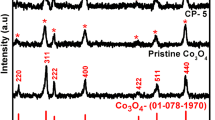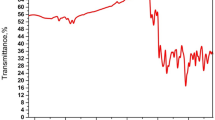Abstract
Bio-derived carbon with distinctive electrical conductivity, electrochemical property, and surface chemistry plays a vital role in the field of energy storage applications. In present work, activated carbon (AC) from D. stramonium seed pod in a cost-effective manner and the electrochemical properties were improved by self-doping of heteroatoms (O, N, S). The 1 M of KOH-induced, O-N-S-doped AC possesses high surface area of 1390 m2/g, 3D-interconnected network-like structure. The O-N-S-doped bio-derived AC activated by 1 M of KOH electrode exhibits specific capacitance of 665.8 F/g at 5 mV/s in three-electrode system and 166.6 F/g at 5 mV/s in supercapacitor (SC) device. The cyclic stability of Z3 was found to be 65% for 5000 cycles in three-electrode systems and 79.07% remains after 1000 cycles in a two-electrode device. The fabricated SC device delivers high energy density of 29.25 Wh/kg at a power density of 2700 W/kg.
Graphical abstract














Similar content being viewed by others
References
Miao Y, Ma Y, Wang Qi (2019) Plasma-assisted simultaneous reduction and nitrogen/sulfur codoping of graphene oxide for high-performance supercapacitors. ACS Sustain Chem Eng 7:7597–7608
Zhu Y, Zhang C, Tang S, Huang H, Wang S, Luo Q, Du Y (2019) Graphene-anchored mesoporous Mn-Co oxide battery-like materials for ultrahigh performance hybrid supercapacitors. ACS Appl Energy Mater 2(10):7546–7553
Zhu Y, Ji X, Wu Z, Song W, Hou H, Wu Z, He X, Chen Q, Banks CE (2014) Spinel NiCo2O4 for use as a high-performance supercapacitor electrode material: understanding of its electrochemical properties. J Power Sources 267:888–900
Halder L, Maitra A, Das AK, Bera R, Karan SK, Paria S, Bera A, Si SK, Khatua BB (2019) Fabrication of an advanced asymmetric supercapacitor based on three-dimensional copper−nickel−cerium−cobalt quaternary oxide and GNP for energy storage application. ACS Appl Electron Mater 1:189–197
Bashir A, Shukla S, Bashir R, Patidar R, Bruno A, Gupta D, Satti MS, Akhter Z (2020) Low temperature, solution processed spinel NiCo2O4 nanoparticles as efficient hole transporting material for mesoscopic n-i-p perovskite solar cells. Sol Energy 196:367–378
Liu B, Liu B, Wang Q, Wang X, Xiang Q, Chen Di, Shen G (2013) New energy storage option: toward ZnCo2O4 nanorods/nickel foam architectures for high-performance supercapacitors. ACS Appl Mater Interfaces 5:10011–10017
Yang P, Ding Y, Lin Z, Chen Z, Li Y, Qiang P, Ebrahimi M, Mai W, Wong C P, Wang Z L (2014) Low-cost high-performance solid-state asymmetric supercapacitors based on MnO2 nanowires and Fe2O3 nanotubes. Nano Lett 14:731–736
Samuel E, Joshi B, Kim Y-i, Aldalbahi A, Rahaman M, Yoon S S (2020) ZnO/MnOx nanoflowers for high-performance supercapacitor electrodes. ACS Sustain Chem Eng 8:3697–3708
Pan Z, Yang J, Zhang Q, Liu M, Hu Y, Kou Z, Liu N, Yang X, Ding X, Chen H, Li J, Zhang K, Qiu Y, Li Q, Wang J, Zhang Y (2019) All-solid-state fiber supercapacitors with ultrahigh volumetric energy density and outstanding flexibility. Adv Energy Mater 9:1802753
Vinayan BP, Zhao-Karger Z, Diemant T, Chakravadhanula VSK, Schwarzburger NI, Cambaz MA, Jürgen Behm R, Kübel C, Fichtner M (2016) Performance study of magnesium–sulfur battery using a graphene based sulfur composite cathode electrode and a non-nucleophilic Mg electrolyte. Nanoscale 8(6):3296–3306
Miao G, Wang W-K, Zhang X, Jiang J, Han-Qing Yu (2018) Fabrication of metallic nickel–cobalt phosphide hollow microspheres for high-rate supercapacitors. J Phys Chem C 122(44):25174–25182
Singh AK, Sarkar D, Karmakar K, Mandal K, Khan GG (2016) High-performance supercapacitor electrode based on cobalt oxide-manganese dioxide-nickel oxide ternary 1D hybrid nanotubes. ACS Appl Mater Interfaces 8(39):25905–25914
Zhang Q, Xu W, Sun J, Pan Z, Zhao J, Wang X, Zhang J, Man P, Guo J, Zhou Z, He B, Zhang Z, Li Q, Zhang Y, Xu L, Yao Y (2017) Constructing ultrahigh-capacity zinc-nickel-cobalt Oxide@Ni(OH)2 core-shell nanowire arrays for high performance coaxial fiber-shaped asymmetric supercapacitors. NanoLett 17(12):7552–7560
Zhang Y, Liu X, Wang S, Dou S, Li Li (2016) Interconnected honeycomb-like porous carbon derived from plane tree fluff for high performance supercapacitors. J Mater Chem A 4(28):10869–10877
Wang L, Baoting Su, Zhao X, Li X, Han S, Jiang J (2020) Appropriate design of electrode material by bio-derived nanopores structure for symmetric supercapacitors. Energy Fuels 34(7):8956–8965
Liu D, Yu S, Shen Y, Chen H, Shen Z, Zhao S, Fu S, Yu Y, Bao B (2015) Polyaniline coated boron doped biomass derived porous carbon composites for supercapacitor electrode materials. Ind Eng Chem Res 54(50):12570–12579
Hou L, Chen Z, Zhao Z, Sun X, Zhang J, Yuan C (2018) Universal FeCl3-activating strategy for green and scalable fabrication of sustainable biomass-derived hierarchical porous nitrogen-doped carbons for electrochemical supercapacitors. ACS Appl Energy Mater 2(1):548–557
Cai J, Zhang D, Ding W-P, Zhu Z-Z, Wang G-Z, He J-R, Wang H-B, Fei P, Si T-L (2020) Promising rice-husk-derived carbon/Ni (OH) 2 composite materials as a high-performing supercapacitor electrode. ACS Omega 5(46):29896–29902
Feng S, Liu Z, Yu Q, Zhuang Z, Chen Q, Fu S, Zhou L, Mai L (2019) Monodisperse carbon sphere-constructed pomegranate-like structures for high-volumetric-capacitance supercapacitors. ACS Appl Mater Interfaces 11(4):4011–4016
Ghosh S, Santhosh R, Jeniffer S, Raghavan V, Jacob G, Nanaji K, Kollu P, Jeong SK, Grace AN (2019) Natural biomass derived hard carbon and activated carbons as electrochemical supercapacitor electrodes. Sci Rep 9(1):1–15
Sun D, Ban R, Zhang P-H, Wu G-H, Zhang J-R, Zhu J-J (2013) Hair fiber as a precursor for synthesizing of sulfur-and nitrogen-co-doped carbon dots with tunable luminescence properties. Carbon 64:424–434
Feng B, Xie J, Dong C, Zhang S, Cao G, Zhao X (2014) From graphite oxide to nitrogen and sulfur co-doped few-layered graphene by a green reduction route via Chinese medicinal herbs. RSC Adv 4(34):17902–17907
Ahmed S, Ahmed A, Rafat M (2018) Supercapacitor performance of activated carbon derived from rotten carrot in aqueous, organic and ionic liquid based electrolytes. J Saudi Chem Soc 22(8):993–1002
Manickavasakam K, Suresh Balaji S, Kaipannan S, Karthick Raj AG, Veeman S, Marappan S (2020) Electrochemical performance of Thespesia populnea seeds derived activated carbon-supercapacitor and its improved specific energy in redox additive electrolytes. J Energy Storage 32:101939
Shang T, Xu Y, Li P, Han J, Wuoo Z, Tao Y, Yang Q-H (2020) A bio-derived sheet-like porous carbon with thin-layer pore walls for ultrahigh-power supercapacitors. Nano Energy 70:104531
Adan-Mas A, Alcaraz L, Arévalo-Cid P, López-Gómez FA, Montemor F (2021) Coffee-derived activated carbon from second biowaste for supercapacitor applications. Waste Manag 120:280–289
Karnan M, Karthick Raj AG, Subramani K, Santhoshkumar S, Sathish M (2020) The fascinating supercapacitive performance of activated carbon electrodes with enhanced energy density in multifarious electrolytes. Sustain Energy Fuels 4(6):3029–3041
Chen X, Zhang J, Zhang B, Dong S, Guo X, Mu X, Fei B (2017) A novel hierarchical porous nitrogen-doped carbon derived from bamboo shoot for high performance supercapacitor. Sci Rep 7(1):1–11
Zhu Q, Zhao D, Cheng M, Zhou J, Owusu KA, Mai L, Yu Y (2019) A new view of supercapacitors: integrated supercapacitors. Adv Energy Mater 9(36):1901081
Momodu D, Madito M, Barzegar F, Bello A, Khaleed A, Olaniyan O, Dangbegnon J, Manyala N (2017) Activated carbon derived from tree bark biomass with promising material properties for supercapacitors. J Solid State Electrochem 21(3):859–872
Li B, Dai F, Xiao Q, Yang Li, Shen J, Zhang C, Cai M (2016) Nitrogen-doped activated carbon for a high energy hybrid supercapacitor. Energy Environ Sci 9(1):102–106
Mirzaeian M, Abbas Q, Hunt M, Hall P (2020) Pseudocapacitive effect of carbons doped with different functional groups as electrode materials for electrochemical capacitors. Energies 13(21):5577
Chen H, Feng Yu, Wang G, Chen L, Dai B, Peng S (2018) Nitrogen and sulfur self-doped activated carbon directly derived from elm flower for high-performance supercapacitors. ACS Omega 3(4):4724–4732
Chang B, Wang Y, Pei K, Yang S, Dong X (2014) ZnCl2-activated porous carbon spheres with high surface area and superior mesoporous structure as an efficient supercapacitor electrode. RSC Adv 4(76):40546–40552
Gopalakrishnan A, Badhulika S (2020) Effect of self-doped heteroatoms on the performance of biomass-derived carbon for supercapacitor applications. J Power Sources 480:228830
Liu H, Liu R, Xu C, Ren Y, Tang D, Zhang C, Li F, Wei X, Zhang R (2020) Oxygen–nitrogen–sulfur self-doping hierarchical porous carbon derived from lotus leaves for high-performance supercapacitor electrodes. J Power Sources 479:228799
Gamby J, Taberna PL, Simon P, Fauvarque JF, Chesneau M (2001) Studies and characterisations of various activated carbons used for carbon/carbon supercapacitors. J Power Sources 101(1):109–116
Subramani K, Sudhan N, Karnan M, Sathish M (2017) Orange peel derived activated carbon for fabrication of high-energy and high-rate supercapacitors. ChemistrySelect 2(35):11384–11392
Yang C-S, Jang YS, Jeong HK (2014) Bamboo-based activated carbon for supercapacitor applications. Curr Appl Phys 14(12):1616–1620
Balducci A, Dugas R, Taberna P-L, Simon P, Plee D, Mastragostino M, Passerini S (2007) High temperature carbon–carbon supercapacitor using ionic liquid as electrolyte. J Power Sources 165(2):922–927
Li X, Han C, Chen X, Shi C (2010) Preparation and performance of straw based activated carbon for supercapacitor in non-aqueous electrolytes. Microporous Mesoporous Mater 131(1–3):303–309
Portet C, Taberna PL, Simon P, Flahaut E (2005) Influence of carbon nanotubes addition on carbon–carbon supercapacitor performances in organic electrolyte. J Power Sources 139(1–2):371–378
Bai S, Tan G, Li X, Zhao Q, Meng Y, Wang Y, Zhang Y, Xiao D (2016) Pumpkin-derived porous carbon for supercapacitors with high performance. Chemistry-Asian J 11(12):1828–1836
Bai P, Wei S, Lou X, Lang Xu (2019) An ultrasound-assisted approach to bio-derived nanoporous carbons: disclosing a linear relationship between effective micropores and capacitance. RSC Adv 9(54):31447–31459
Mo R-J, Zhao Y, Min Wu, Xiao H-M, Kuga S, Huang Y, Li J-P, Shao-Yun Fu (2016) Activated carbon from nitrogen rich watermelon rind for high-performance supercapacitors. RSC Adv 6(64):59333–59342
Subramanian V, Luo C, Stephan AM, Nahm KS, Thomas S, Wei B (2007) Supercapacitors from activated carbon derived from banana fibers. J Phys Chem C 111(20):7527–7531
Karnan M, Subramani K, Sudhan N, Ilayaraja N, Sathish M (2016) Aloe vera derived activated high-surface-area carbon for flexible and high-energy supercapacitors. ACS Appl Mater Interfaces 8(51):35191–35202
Acknowledgements
The authors extend their appreciation to the Researchers Supporting Project number (RSP-2021/396), King Saud University, Riyadh, Saudi Arabia.
Author information
Authors and Affiliations
Corresponding author
Additional information
Publisher's note
Springer Nature remains neutral with regard to jurisdictional claims in published maps and institutional affiliations.
Supplementary Information
Below is the link to the electronic supplementary material.
Rights and permissions
About this article
Cite this article
Subramanian, D., Raju, G., Palanivel, B. et al. Exploration of O-N-S heteroatom self-doped mesoporous activated carbon derived from Datura stramonium seed pods as a potential electrode for supercapacitor application. Ionics 28, 2363–2375 (2022). https://doi.org/10.1007/s11581-022-04464-z
Received:
Revised:
Accepted:
Published:
Issue Date:
DOI: https://doi.org/10.1007/s11581-022-04464-z




